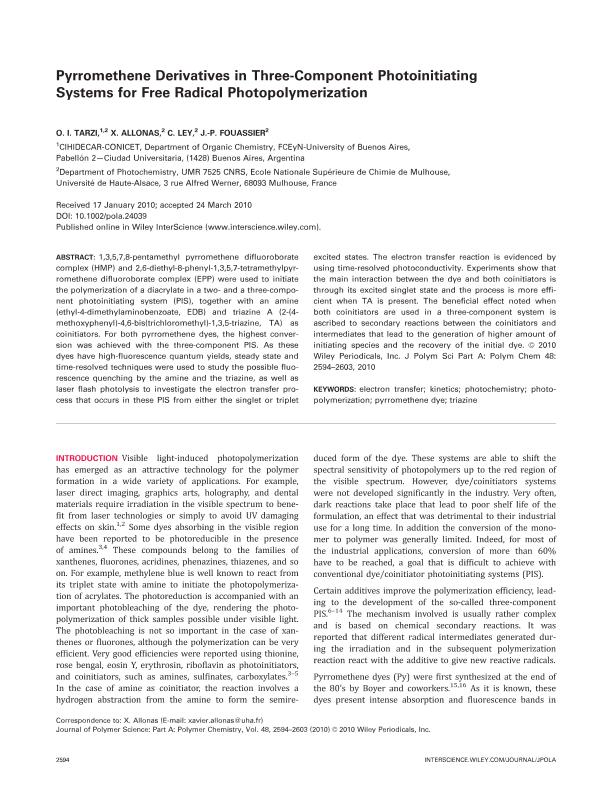Mostrar el registro sencillo del ítem
dc.contributor.author
Tarzi, Olga Inés

dc.contributor.author
Allonas, X.
dc.contributor.author
Ley, C.
dc.contributor.author
Fouassier, J. P.
dc.date.available
2019-01-28T20:47:53Z
dc.date.issued
2010-06
dc.identifier.citation
Tarzi, Olga Inés; Allonas, X.; Ley, C.; Fouassier, J. P.; Pyrromethene derivatives in three-component photoinitiating systems for free radical photopolymerization; John Wiley & Sons Inc; Journal of Polymer Science Part A: Polymer Chemistry; 48; 12; 6-2010; 2594-2603
dc.identifier.issn
0887-624X
dc.identifier.uri
http://hdl.handle.net/11336/68823
dc.description.abstract
1,3,5,7,8-pentamethyl pyrromethene difluoroborate complex (HMP) and 2,6-diethyl-8-phenyl-1,3,5,7-tetramethylpyrromethene difluoroborate complex (EPP) were used to initiate the polymerization of a diacrylate in a two- and a three-component photoinitiating system (PIS), together with an amine (ethyl-4-dimethylaminobenzoate, EDB) and triazine A (2-(4methoxyphenyl)-4,6- bis(triehloromethyl)-1,3,5-triazine, TA) as coinitiators. For both pyrromethene dyes, the highest conversion was achieved with the three-component PIS. As these dyes have high-fluorescence quantum yields, steady state and time-resolved techniques were used to study the possible fluorescence quenching by the amine and the triazine, as well as laser flash photolysis to investigate the electron transfer process that occurs in these PIS from either the singlet or triplet excited states. The electron transfer reaction is evidenced by using time-resolved photoconductivity. Experiments show that the main interaction between the dye and both coinitiators is through its excited singlet state and the process is more efficient when TA is present. The beneficial effect noted when both coinitiators are used in a three-component system is ascribed to secondary reactions between the coinitiators and intermediates that lead to the generation of higher amount of initiating species and the recovery of the initial dye.
dc.format
application/pdf
dc.language.iso
eng
dc.publisher
John Wiley & Sons Inc

dc.rights
info:eu-repo/semantics/openAccess
dc.rights.uri
https://creativecommons.org/licenses/by-nc-sa/2.5/ar/
dc.subject
Electron Transfer
dc.subject
Kinetics
dc.subject
Photochemistry
dc.subject
Photopolymerization
dc.subject
Pyrromethene Dye
dc.subject
Triazine
dc.subject.classification
Otras Ciencias Químicas

dc.subject.classification
Ciencias Químicas

dc.subject.classification
CIENCIAS NATURALES Y EXACTAS

dc.title
Pyrromethene derivatives in three-component photoinitiating systems for free radical photopolymerization
dc.type
info:eu-repo/semantics/article
dc.type
info:ar-repo/semantics/artículo
dc.type
info:eu-repo/semantics/publishedVersion
dc.date.updated
2019-01-28T14:04:19Z
dc.journal.volume
48
dc.journal.number
12
dc.journal.pagination
2594-2603
dc.journal.pais
Estados Unidos

dc.description.fil
Fil: Tarzi, Olga Inés. Université de Haute-Alsace; Francia. Consejo Nacional de Investigaciones Científicas y Técnicas; Argentina
dc.description.fil
Fil: Allonas, X.. Université de Haute-Alsace; Francia
dc.description.fil
Fil: Ley, C.. Université de Haute-Alsace; Francia
dc.description.fil
Fil: Fouassier, J. P.. Université de Haute-Alsace; Francia
dc.journal.title
Journal of Polymer Science Part A: Polymer Chemistry

dc.relation.alternativeid
info:eu-repo/semantics/altIdentifier/doi/http://dx.doi.org/10.1002/pola.24039
dc.relation.alternativeid
info:eu-repo/semantics/altIdentifier/url/https://onlinelibrary.wiley.com/doi/abs/10.1002/pola.24039
Archivos asociados
